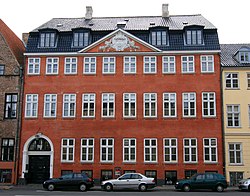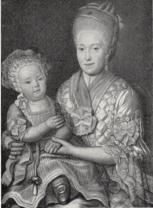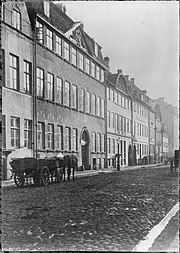
Ploug House is a listed Neoclassical property on the corner of Højbro Plads and Ved Stranden in central Copenhagen, Denmark. It dates from the building boom which followed after the Copenhagen Fire of 1795 but takes its name from the poet, publisher and politician Carl Ploug who lived there in the 1860s and 1870s and also published the newspaper Fædrelandet from the premises.

The Lehn House is a historic townhouse on Strandgade in the Christianshavn neighbourhood of central Copenhagen, Denmark. It is also known as the Tordenskjold House after Peter Jansen Wessel Tordenskiold commonly referred to as Tordenskjold, who for a while lived in the building. The Danish Authors' Society is now based in the property whose meeting facilities are also rented out for events. The rooms are notable for their lavish stucco ceilings and murals.

The Strandgade 24 is a listed Neoclassical townhouse located on Strandgade in Copenhagen, Denmark.

The Cort Adeler House is a historic property located at Strandgade 22 in the Christianshavn neighbourhood of Copenhagen, Denmark. It takes its name from Admiral Cort Adeler who lived there for the last seven years of his life in the 17th century.

The Niels Brock House is a historic property located at Strandgade 36 in the Christianshavn neighbourhood of Copenhagen, Denmark. The property comprises the former warehouse at Wildersgade 51 on the other side of the block as well as a number of side wings in the yard. The building takes its name after the businessman Niels Brock for whom it was adapted in the 1780s. Other notable former residents include the historian Peter Vilhelm Jacobsen (1799–1848) and the businessman Christian August Broberg. The entire complex was listed in the Danish registry of protected buildings and places in 1918.

The Jennow House is a historic property located at Strandgade 12 in the Christianshavn neighbourhood of Copenhagen, Denmark. It takes its current name after Andreas Jennow, a businessman who owned it from 1949 to 1978. His company Andreas Jennow A/S was based in the building until 1988.

The Schottmann House Danish: is a historic property located at Strandgade 10 in the Christianshavn neighbourhood of Copenhagen, Denmark.

The Rhode House is a historic property located at the corner of Strandgade and Torvegade in the Christianshavn neighbourhood of central Copenhagen, Denmark.

The Jacob Holm House is a historic property located at Strandgade 4B in the Christianshavn neighbourhood of Copenhagen, Denmark. It was owned by the wealthy industrialist and shipowner Jacob Holm from 1819 to 1845.
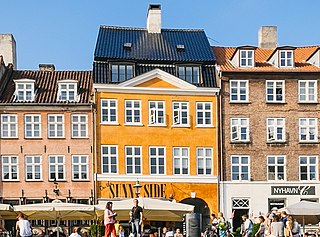
Nyhavn 31 is a listed property overlooking the Nyhavn canal in central Copenhagen, Denmark.

Nyhavn 11 is an 18th-century property overlooking the Nyhavn canal in central Copenhagen, Denmark. Ludvig Ferdinand Rømer established a sugar refinery on the property in 1653 and it was later continued by changing owners until at least the 1860s. A small figure of a sugar-baker holding a sugar cone is still seen above the gate. The building was listed in the Danish registry of protected buildings and places in 1932. Notable former residents include the general trader Jacob Severin and actors Christen Niemann Rosenkilde, Julie Sødring and Poul Reumert. The lamp manufacturer Louis Poulsen was later based in the building from 1908 to 2006.

The Verrayon House is a Rococo, bourgeoisie townhouse located at Lille Strandstræde 6 in central Copenhagen, Denmark. It was listed by the Danish Heritage Agency in the Danish national registry of protected buildings in 1943.

Købmagergade 5 is a 17th-century property situated on the shopping street Købmagergade, close to Amagertorv and Strøget, in central Copenhagen, Denmark. Constructed as part of the rebuilding of the city following the Copenhagen Fire of 1728 it was later heightened with one storey. The building was listed in the Danish registry of protected buildings and places in 1971. Petitgas Eftf., for many years Denmark's oldest hats store, occupied the ground floor from 1857 until 2020.

Nyhavn 27 is an 18th-century property overlooking the Nyhavn Canal in central Copenhagen, Denmark. The building was listed in the Danish registry of protected buildings and places in 1945. Notable former residents include businessman Andreas Bodenhoff.
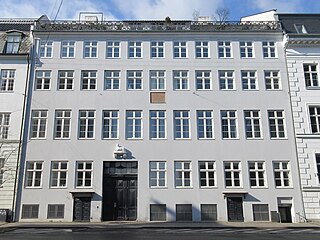
Kvæsthusgade 5 is a historic property in Kvæsthusgade, a short street between the Nyhavn canal and Sankt Annæ Plads, in central Copenhagen, Denmark. The building is listed in ht Danish registry of protected buildings and places. Notable former residents include the military officer Christian de Meza, composer Niels Gade. painter Anna Petersen and art historian Troels Troels-Lund.

Nyhavn 47 is an 18th-century property situated at the corner of Nyhavn and Toldbodgade in central Copenhagen, Denmark. It owes its current appearance to a renovation undertaken by Julius Andreas Blom in 1842–45. It was listed in the Danish registry of protected buildings and places in 1932. Notable former residents include the merchant and shipowner Peter Christian Knudtzon.

Nyhavn 45 is an 18th-century property overlooking the Nyhavn Canal in central Copenhagen, Denmark. It was listed in the Danish registry of protected buildings and places in 1945.
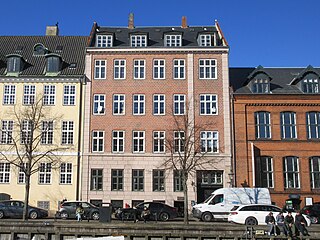
Overgaden Neden Vamdet 15 is a mid-19th-century property overlooking the Christianshavn Canal in the Christianshavn neighborhood of central Copenhagen, Denmark. It consists of an L-shaped building with high-end apartments from 1858 fronting the street and an older rear wing now used as office space, ateliers and storage space. The two buildings were both listed in the Danish registry of protected buildings and places in 1980. Notable former residents include the businessman Peter Heering and the author Henrik Pontopidan.

Amagertorv 11/Læderstræde 11 is a Neoclassical property situated on the shopping street Strøget in central Copenhagen, Denmark. Constructed in 1798–1802 as part of the rebuilding of the city following the Copenhagen Fire of 1795, it owes its current appearance to two renovation undertaken in 1884 and 1903. The property was from around 1810 to 1845 owned by Gerson Melchior, owner of Moses & Søn G. Melchior. His sons Moses Melchior and Moritz G. Melchior, who would eventually continue the family firm, and Israel B. Melchior, an engineer and photographer, grew up in the building. In 1856, Melchior's heirs sold the property to wholesaler Sabinus Seidelin, whose trading firm S. Seidelin was subsequently operated from the rear wing. In 1903, S. Seidelin relocated to a new head office at Skindergade 7.

Nyhavn 17 is a late 17th-century building situated at the corner of Nyhavn and Lille Strandstræde in central Copenhagen, Denmark. It was listed on the Danish registry of protected buildings and places in 1951. Tattoo-Ole, a tattoo shop located in the basement, claims to be the oldest still functioning tattoo shop in the world.
